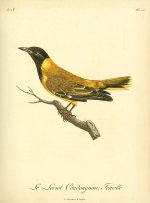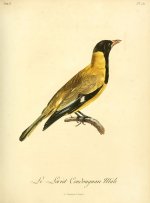Björn Bergenholtz
(former alias "Calalp")

Here´s some other of James Jobling's "unseen" OD's … that I´ve found apparently "missing", while scrolling through the HBW Alive Key looking for Swedish naturalist.
None of these names are (at least this far) in my MS (of "Swedish" etymologies to solve) thereby I will not investigate them any further.
Although I hope they can help James in his gigantic work.
Or anyone else interested!
Well, here goes:
No. 1:
● "Apalis catiodes" REICHENOW 1908 … OD, here.
No. 2:
● … regarding the entry "cernutii" … is maybe some kind of typo … from somewhere? It is "Emberiza Cerrutii" DE FILIPPI ... OD, here.
PS. Full article also attached. Note the name "E. Schah" in the end of the OD of "Cerrutii". I don't think that name is present in the HBW Alive Key!? Or is that maybe just (another) typo, this time of Emberiza shah BONAPARTE?
No. 3:
● "Rallus circoleps" (often quoted to LESSON 1831, which is found here … however it, in its turn, simply refers to "Gallinula circoleps" by TEMMINCK (a bird of which I now nothing).
Also see this text (here) by Walden, and regarding the "identity" of "circoleps", see page 341, here.
No. 4:
● "Oriolus coudougan" TEMMICK 1825 ...
Neither I have seen the OD "1825" however the Nouveau recueil de planches coloriées d'oiseaux : pour servir de suite et de complément aux planches enluminées de Buffon (Edition 1838) in BDL is found here, and the reference to "Loriot Coudougnan” of Levaillant 1808, is found in his Histoire naturelle des Oiseaux d'Afrique, vol. 6, p.53-54 … ( here). References are also made to the Plates 261 (male) and 262 (female), both attached.
Maybe those pages reveal the etymology?
No. 5:
● "Francolinus cruzi" THEMIDO 1937
Still unseen, but this one looks like the item searched for is: THEMIDO, António (1937) Un nouveau "Francolinus" de l'Angola. Comptes rendus du XIIe Congrès International de Zoologie, Lisbonne, 1935. Vol. III, Section IX: Vertébrés. Arquivos do Museu Bocage, 6-A, 1935: 1834-1834. Aves. Angola
No. 6:
● "Columba denisea" TEMMINCK 1830 a k a (in French) "Colombe Denise" ... OD, here.
No. 7:
● the subspecies Zosterops senegalensis gerhardi VAN DEN ELZEN & KÖNIG 1983 (OD, here).
No. 8:
● grucheti (OD, attached) … also incl. Marscarenotus.
No. 9:
● icariotis … is found on p.58 in L'institut. Section 1: Sciences mathématiques, physiques et naturelles, Vol. 6 (here).
No. 10:
● jacqueti … OD here.
No. 11:
● judith … OD, here.
● ceciliae … in "Polytmus (Campylopterus) Cecilae"
No. 12:
● libussa
● lydia
… are both found in the "Extraheft": Aufzählung der Colibris Oder Trochilideen in ihrer wahren natürlichen Verwandtschaft, nebst Schlüssel ihrer Synonymik (here).
To be continued ...
x
None of these names are (at least this far) in my MS (of "Swedish" etymologies to solve) thereby I will not investigate them any further.
Although I hope they can help James in his gigantic work.
Or anyone else interested!
Well, here goes:
No. 1:
● "Apalis catiodes" REICHENOW 1908 … OD, here.
No. 2:
● … regarding the entry "cernutii" … is maybe some kind of typo … from somewhere? It is "Emberiza Cerrutii" DE FILIPPI ... OD, here.
PS. Full article also attached. Note the name "E. Schah" in the end of the OD of "Cerrutii". I don't think that name is present in the HBW Alive Key!? Or is that maybe just (another) typo, this time of Emberiza shah BONAPARTE?
No. 3:
● "Rallus circoleps" (often quoted to LESSON 1831, which is found here … however it, in its turn, simply refers to "Gallinula circoleps" by TEMMINCK (a bird of which I now nothing).
Also see this text (here) by Walden, and regarding the "identity" of "circoleps", see page 341, here.
No. 4:
● "Oriolus coudougan" TEMMICK 1825 ...
Neither I have seen the OD "1825" however the Nouveau recueil de planches coloriées d'oiseaux : pour servir de suite et de complément aux planches enluminées de Buffon (Edition 1838) in BDL is found here, and the reference to "Loriot Coudougnan” of Levaillant 1808, is found in his Histoire naturelle des Oiseaux d'Afrique, vol. 6, p.53-54 … ( here). References are also made to the Plates 261 (male) and 262 (female), both attached.
Maybe those pages reveal the etymology?
No. 5:
● "Francolinus cruzi" THEMIDO 1937
Still unseen, but this one looks like the item searched for is: THEMIDO, António (1937) Un nouveau "Francolinus" de l'Angola. Comptes rendus du XIIe Congrès International de Zoologie, Lisbonne, 1935. Vol. III, Section IX: Vertébrés. Arquivos do Museu Bocage, 6-A, 1935: 1834-1834. Aves. Angola
No. 6:
● "Columba denisea" TEMMINCK 1830 a k a (in French) "Colombe Denise" ... OD, here.
No. 7:
● the subspecies Zosterops senegalensis gerhardi VAN DEN ELZEN & KÖNIG 1983 (OD, here).
Derivatio nominis: Wir benennen diesen Brillenvogel nach seinem Sammler Herrn Gerhard Nikolaus, der durch seine Aktivitäten einen großen Beitrag zur Kenntnis der Avifauna des Sudan geleistet hat.
No. 8:
● grucheti (OD, attached) … also incl. Marscarenotus.
No. 9:
● icariotis … is found on p.58 in L'institut. Section 1: Sciences mathématiques, physiques et naturelles, Vol. 6 (here).
No. 10:
● jacqueti … OD here.
No. 11:
● judith … OD, here.
The same article in the Annali del Reale Museo di Fisica e Storia Naturale di Firenze (Nuova Serie), Volume 1 … also includes:"Dedicata la presente specie allʼegregia ... GIUDITTA MARCHETTINI in segno di amicizia e di stima."
● ceciliae … in "Polytmus (Campylopterus) Cecilae"
● ridolfii …. in the "Mellisuga (Eriocnemis) Ridolfii"Dedicata la presente specie ... CECILIA TURRI.
The latter not "unseen" in the HBW Alive Key, but might be worth checking a second time!?Dedicata questa specie a S. E. il marchese COSIMO RIDOLFI Direttore del Museo di Fisica e Storia Naturale di Firenze e Senatore del Regno.
No. 12:
● libussa
● lydia
… are both found in the "Extraheft": Aufzählung der Colibris Oder Trochilideen in ihrer wahren natürlichen Verwandtschaft, nebst Schlüssel ihrer Synonymik (here).
To be continued ...
x
Attachments
Last edited:






